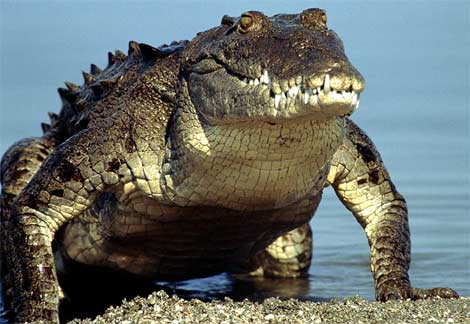|

Description
Crocodiles are similar to alligators and caiman; for their common biology and differences between them, see crocodile
Crocodiles, like dinosaurs, have the abdominal ribs modified
into gastralia Crocodiles are among the more biologically complex reptiles despite their prehistoric look. Unlike other reptiles,
they incorporate muscles used for aquatic locomotion into respiration giving them the functional equivalent of a diaphragm.
. Their external morphology on the other hand is a sign of their aquatic and predatory lifestyle. A crocodile’s physical
traits allow it to be a successful predator
. They have a streamlined body that enables them to swim swiftly. Crocodiles also tuck their feet to their sides while swimming,
which makes them faster by decreasing water resistance. They have webbed feet which, although not used to propel the animal
through the water, allow it to make fast turns and sudden moves in the water or initiate swimming. Webbed feet are an advantage
in shallower water where the animals sometimes move around by walking. The palate has a special path from the nostril to the
glottis that bypasses the mouth. Crocodilian scales have pores that are believed to be sensory, analogous to the lateral line in fishes. They are particularly seen on their upper and lower jaws. Another possibility
is that they are secretory, as they produce an oily substance that appears to flush mud off.
Crocodiles are very fast over short distances, even out of water. They have extremely powerful jaws capable of biting
down with immense force, by far the strongest bite of any animal. The crocodile's bite force is more than 5,000 pounds per
square inch, compared to just 335 psi for a rottweiler,400 psi for a large great white shark, or 800 to 1,000 psi for a hyena.
They have sharp teeth for tearing and holding onto flesh, but cannot open their mouth if it is held closed. Since crocodiles
feed by grabbing and holding onto their prey, they have evolved powerful muscles that close the jaws and hold them shut. The
jaws are opened, however, by a very weak set of muscles. Crocodiles can thus be subdued for study or transport by taping their
jaws or holding their jaws shut with large rubber bands cut from automobile inner tubes.. All crocodiles have sharp and powerful
claws. They have limited lateral (side-to-side) movement in their neck.
Age
There is no reliable way of measuring crocodile age, although several techniques
are used to derive a reasonable guess. The most common method is to measure lamellar growth rings in bones and teeth—each
ring corresponds to a change in growth rate which typically occurs once a year between dry and wet seasons. Bearing these inaccuracies in mind, the oldest crocodilians appear to be the largest species. C. porosus is
estimated to live around 70 years on average, and there is limited evidence that some individuals may exceed 100 years. One
of the oldest crocodiles recorded died in a zoo in Russia. A male freshwater crocodile at the Austrlia
Zoo is
estimated to be 130 years old. He was rescued from the wild by Bob lrwin and Steve
lrwin after being shot twice by hunters. As a result of the shootings, this crocodile (known affectionately as "Mr.
Freshy") has lost his right eye.
Size
Large saltwater
Crocodile in captivity in Australia.
Size greatly varies between species, from
the Dwarf crocodile to the saltwater Crocodile Species of Palaeosuchus and Osteolaemus grow to an adult size
of just 1 to 1.5 m. Larger species can reach over 4.85 m (16 ft) long and weigh well over 1200 kg (2,640 lb). Crocodilians
show pronounced Sexual dimorphism with males growing much larger and more rapidly than females. Despite their large adult
size, crocodiles start their life at around 20 cm (8 inches) long. The largest species of crocodile is the saltwater Crocodile,
found in northern Australia, throughout south-east Asia and in the surrounding waters. The largest recorded crocodile is a
giant saltwater crocodile measured at 8.6 meters (28.2 ft) and 1352 kg weight (2870 lb) shot in Australia, Queensland in 1957.
A "replica" of this crocodile has been made as a tourist attraction. The largest living crocodile known is a 7.1 m (25.3 ft)
long saltwater Crocodile, in Orissa, India. It lives in Bhitarkanika Wildlife Sanctuary and in June 2006, was entered in the
Guinness Book of World Records. Two larger certifiable
records are both of 6.2 m crocodiles. The first crocodile was shot in the Mary River in the Northern territory of Australia in 1974 by poachers and measured by wildlife rangers citation needed. The second crocodile was
killed in 1983 in the Fly River, Papua New Guinea In the case of the second crocodile it was actually the skin that was measured by zoologist Jerome Montague,
and as skins are known to underestimate the size of the actual animal, it is possible this crocodile was at least another
10 cm longer. citation needed..
|
 |
|

